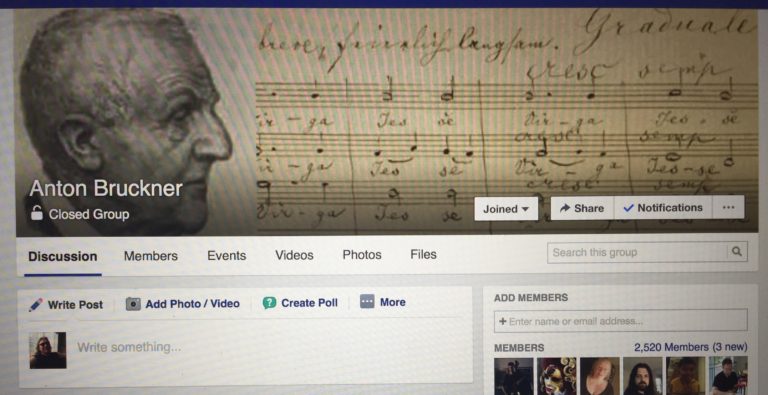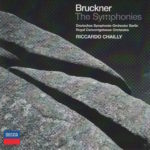
Just wanted to let everyone know about a very cool Facebook group devoted to Anton Bruckner, which you can find here.
It’s a robust group, with many active members, people who are passionate about the group’s namesake, as well as music in general.
Check them out.
Now, on to our regularly scheduled program…
 This morning’s conductor of Anton Bruckner’s Symphony No. 5 in B-Flat Major (WAB 105) – nicknamed “Tragic,” “Church of Faith,” or “Pizzicato” symphony (for reasons I’m still discovering), is Italian Riccardo Chailly (1953-). The orchestra is Royal Concertgebouw Orchestra.
This morning’s conductor of Anton Bruckner’s Symphony No. 5 in B-Flat Major (WAB 105) – nicknamed “Tragic,” “Church of Faith,” or “Pizzicato” symphony (for reasons I’m still discovering), is Italian Riccardo Chailly (1953-). The orchestra is Royal Concertgebouw Orchestra.
I discovered something interesting this morning.
When I listen to music, I often hear the melodies for other – often more contemporary – songs.
For example, on Day 1, I heard a striking similarity between the Scherzo in Bruckner’s Third Movement and the theme song for Agatha Christie’s Poirot TV series.
Here’s Daniel Barenboim’s interpretation of the Scherzo to Bruckner’s First.
Here’s the theme song to Agatha Christie’s Poirot TV series.
Granted, those aren’t duplicates of one other. But there was enough in the former – a mere whiff of similarity in cadence and structure – to make me think of the latter.
This morning, in the Finale to Bruckner’s Fifth, I heard the melody to Tip Toe Through the Tulips, written in 1929 and popularized by Tiny Tim in the late 1960s.
It’s just a mere eight seconds in length, stuck near the middle of the Finale. But there was enough of the melody of the Tiny Tim song to make me think of it.
Someone has uploaded the entire Symphony No. 5 in B Flat Major conducted by Chailly. I found the part in the Finale. Listen for yourself here. It’s the violin in the background.
Now listen – for as long as you can stomach it – to Tiny Tim performing the song on Rowan & Martin’s Laugh In.
Compare the two melodies.
Again, they are not duplicates. But there’s enough of the former in the latter to be reminiscent of one another.
Enough about tip toeing through the tulips.
Back to Riccardo Chailly.
 I first heard Maestro Chailly on Day 2 of my 144-day project.
I first heard Maestro Chailly on Day 2 of my 144-day project.
Then again on Day 18.
Then on Day 34.
Most recently on Day 50.
Now, for the nuts and bolts of today’s performance:
Bruckner’s Symphony No. 5 in B-Flat Major (WAB 105) composed in 1875-1876
Riccardo Chailly conducts
Chailly used the ???? version listed as “Haas edition” on the CD sleeve and in the liner notes (I’m guessing Chailly is playing the 1878 version, but why should I have to guess?)
Royal Concertgebouw Orchestra plays
The symphony clocks in at 75:29 (but doesn’t deserve a “Yikes!” modifier because it’s just a longer symphony – at least, that’s my guess at this point)
This was recorded in Berlin, Germany, in June of 1991
Chailly was 38 when he conducted it
Bruckner was 51 when he finished composing it
This recording was released on the Decca label
Bruckner wrote his symphonies in four parts. The time breakdown of this one (Symphony No. 5 in B Flat Major, “Haas edition”), from this particular conductor (Chailly) and this particular orchestra (Royal Concertgebouw Orchestra) is as follows:
I. Introduction (Adagio) — Allegro. B-flat major……………………………20:24
II. Adagio. Sehr langsam. (Very slowly) D minor……………………………18:07
III. Scherzo. Molto vivace D minor…………………………………………………13:07
IV. Finale (Adagio) — Allegro moderato. B-flat major…………………..23:31
Total running time: 75:29
From the liner notes by Andrew Huth,
The Fifth, Sixth and Seventh Symphonies, on the other hand, were never subject to revision. Composed between 1875 and 1883, they stand at the centre of Bruckner’s life and work as achievements of compelte and confident maturity. The Fifth Symphony draws much of its strength from an austerity, almost severity, of orchestral colour which ensures that nothing will distract from its closely woven contrapuntal textures and the clear logic of its formal progress.
Well written and insightful!
 From the excellent book The Essence of Bruckner by Robert Simpson (pages 112, 115),
From the excellent book The Essence of Bruckner by Robert Simpson (pages 112, 115),
The whole symphony was done by May 1876. He retouched it in 1878, but not again after that, and its first publication was supervised by Franz Schalk during the composer’s last illness in 1896.
No symphony ever opened like this. Another silence, and with the added force of the timpani thundered forth on B flat major. As before it ceases abruptly, and again the brass deliver the paean…now on the dominant of A. Silence.
This magnificent and unique opening, with its great blocks of sound confronting each other on different harmonic pedestals, separated by open spaces, has already set up a vast momentum, slower than Bruckner had hitherto conceived.
This is why I spent a small fortune buying hard-to-find or out-of-print books about Bruckner and his symphonies. Simpson’s book adds so much to my enjoyment of the symphony.
Okay. Now for the subjective stuff…
My Rating:
Recording quality: 4
Overall musicianship: 5
CD liner notes: 3 (short essay in three languages)
How does this make me feel: 4
This time around, I liked Bruckner’s Fifth. I wasn’t sold on it the first time I heard it (yesterday – Day 65) because it sounded like this impenetrable piece of music that I couldn’t find a way to latch onto.
Today, however (even though I still am not hearing anything that immediately jumps out at me) I found the recording much more enjoyable.
This must be the “magic” to which I refer from time to time. Maestro Chailly’s interpretation has that extra something that makes me sit up and take notice.
I’ll have to continue listening to this symphony. It’s not my favorite of the four I’ve heard to date.
But, thanks to comments from people who tell us it’s their favorite, and thanks to books like Simpson’s that explain exactly why Bruckner’s Fifth is so important, I think I’ll continue to listen with rapt attention.

Hey, nice stuff ! 5 is my third favorite of Bruckner symphonies, ie. after 8 and 9.
In fact I can give you my whole rank ! 8, 9, 5, 3, 7, 2, 4, 1 and 6.
Mind the gap, please.
I think you already saw many Brucknerians who collect at least 30 titles for each work, and I’m afraid I’m one of them too ! My favorite 5 performances are Jochum(Bayerin Radio, DG), Dohnany and Sinopoli. I recently added Abbado’s Lucerne one too.
I find the above liner note of ‘austerity’ very insightful. I completely agree on this view, and my choice of performances are very well suited in this sense. Many conductors don’t seem to agree on this point, like Karajan, Thielemann, Celibidache, Maazel etc. Chailly or Haitink really are on the middle of the above school, methinks.
This is the first blog article I found here, and I just can’t help writing a short one here !! Will have to look up other articles, which I find fascinating. No doubt you’ll see many of my comment here soon !
Cheers,
ps. I hope you understand my Enlish-like Konglish !
Thank you for stopping by, Kidon. I appreciate your comments, and I look forward to reading more.
OOOps, the gap is gone… 8,9,5__3,7,2,4___1,6